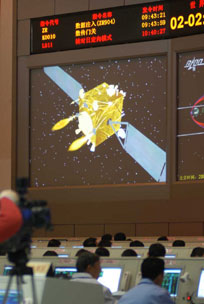Chang'e I carried out its first orbital correction on Friday morning in a bid to ensure it travels on its preset orbit.
 A screen displays a simulated image of Chang'e I as it carried out orbital corrections, November 2, 2007. [Xinhua]
A screen displays a simulated image of Chang'e I as it carried out orbital corrections, November 2, 2007. [Xinhua] |
The Beijing Aerospace Control Center (BACC) issued the instructions at 10:25 am on Friday, when two small engines on Chang'e I were ignited to slightly modulate its trajectory.
Eight minutes later, the orbital correction was completed.
The move, which was scheduled to be carried out on Thursday, was canceled as the probe was traveling on the expected trajectory in an "unexpectedly precise" way after it left the Earth orbit late on Wednesday, BACC chief engineer Wang Yejun, said.
"Data shows we have reached our expectation through the orbital correction," he said.
"That's also the reason why we didn't employ the main engine on Chang'e I for the first orbital correction, because it is not necessary and it also saves energy for the orbiter's future operation," he said.
A second orbital correction might be carried out on Sunday, Wang said.
Pang Zhihao, a researcher with the China Academy of Space Technology, said orbital correction is necessary to prevent an orbiter from veering off its projected course.
"An aircraft faces many disturbances, such as gravitation from celestial bodies. When it travels in space, we have to carry out corrections to ensure it moves on the right track," Pang said.
"Just like driving a car, we must keep turning the steering wheel to ensure the car stays on the road," he said.
Chang'e I entered the Earth-moon transfer orbit on Wednesday and is expected to arrive at the lunar orbit at 11:25 am on Monday.
Once it becomes a real circumlunar satellite after being captured by lunar gravity, the satellite will relay its first pictures of the moon in late November
It will then continue scientific explorations of the moon for a further year.
